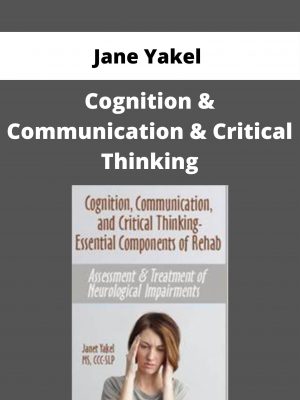John W. O’Halloran – The Clinician’s Go-To Guide for Joint Arthroplasty, Geriatrics is Now Geri-Active!
$200 Original price was: $200.$75Current price is: $75.
Shopping Instructions:
- DISCOUNT 15% : SHOP15
- Product Delivery: Within 1 – 12 hours after purchase.
Also examined will be surgery from traditional to cutting edge, in addition to evidenced-based rehab and return to activity guidelines. This one of a kind recording is a MUST for all clinicians who work with total joint patients.
John W. O’Halloran – The Clinician’s Go-To Guide for Joint Arthroplasty, Geriatrics is Now Geri-Active!
The World Health Organization dubbed the years 2000-2010 the “Bone and Joint Decade”. By 2020, joint arthroplasty rates are expected to double. This rise in the demand for joint replacement surgery has led to major advancements in the surgical techniques and technologies. These developments allow patients to return to an active lifestyle, where before they were very much limited. The question for clinicians is: are we ready to provide current and progressive rehabilitation for the rising joint replacement population? Today’s “Baby Boomer” joint replacement patient places much higher expectations on their rehab provider. They want to get down on the floor with the grandkids, ski and hike.
This highly interactive recording will provide you with the evidenced-based knowledge to answer those often on-the-spot questions our patients ask, such as “What should I not do?” or “When can I hike or play tennis again?” Also examined will be surgery from traditional to cutting edge, in addition to evidenced-based rehab and return to activity guidelines. This one of a kind recording is a MUST for all clinicians who work with total joint patients.
- Discover the latest surgical joint replacement techniques, such as Computer Assisted Surgery, tissue sparring, resurfacing, and minimally invasive procedures
- Grasp the rehab implications of the latest surgical advancements
- Cover the latest evidence-based techniques and technologies in pre and post-operative therapy
- Determine when it is safe for your patients to resume which activities
- Design functional rehabilitation exercise programs
CURRENT TRENDS AND STATISTICS
- Shoulder, knee, and hip arthroplasty
- Core Implications for joint replacement patients
SHOULDER ARTHROPLASTY: NEW ADVANCES IN SURGICAL AND REHAB IMPLICATIONS
- Osteoarthritis of the shoulder management
- Complete Total Shoulder Arthroplasty (TSA)
- Hemi shoulder arthroplasty
- Reverse Total Shoulder Arthroplasty (rTSA)
- Humeral resurfacing
- Interpositional arthroplasty
- Glenoid resurfacing
- Rehabilitation techniques following Total Shoulder Arthroplasty
- Range of motion guidelines
- Open and closed chain exercises
- Kinetic chain experiences
- Return to activities following Total Shoulder Arthroplasty
- Rehabilitation techniques following Total Shoulder Arthroplasty
Would you like to receive John W. O’Halloran – The Clinician’s Go-To Guide for Joint Arthroplasty, Geriatrics is Now Geri-Active! ?
TOTAL KNEE ARTHROPLASTY (TKA)
- Traditional Total Knee Arthroplasty
- Minimally Invasive Knee Arthroplasty (MIS TKA)
- Less Invasive/Quad Sparring Total Knee Arthroplasty
- Computer Assisted Surgery (CAS)
- Review of literature on Continuous Passive Motion (CPM)
- Review of literature on Neuromuscular Electrical Stimulation
- Review of literature on pre-operative physical therapy
- Return to activities following Total Knee Arthroplasty
- Learn when it is acceptable for your patients to:
- Swim
- Bike
- Use the treadmill
- Hike
- Use the elliptical
- Facilitate use of key gait and function muscles weakened by TKA?
CASE STUDIES
TOTAL HIP ARTHROPLASTY (THA)
- Traditional total hip precautions with a compare and contrast to the more advanced hip systems of today
- Anterior Hip Arthroplasty—rehab implications
- Minimally Invasive Hip Arthroplasty (MIS THA)
- Advances in materials in THA and the rehab implications, especially the typical precautions, etc.
- How to facilitate key muscles involved in gait and function for your THA patient
- Return to activities following Total Hip Arthroplasty
- Learn when it is acceptable for your patients to:
- Swim
- Bike
- Use the treadmill
- Hike
- Use the elliptical
- Examine which sports are allowed following THA?
Related products
NLP & Hypnosis
NLP & Hypnosis
Joseph Cohen – The SelfHacked Secrets To Understanding Why You Are Sick And How To Get Well
NLP & Hypnosis
NLP & Hypnosis
iAwake Technologies – Beginner’s Mind (Neuroflow Series) [6 WebRips – WAV User Manual – PDF]
NLP & Hypnosis
NLP & Hypnosis
NLP & Hypnosis
NLP & Hypnosis








![Iawake Technologies – Beginner’s Mind (neuroflow Series) [6 Webrips – Wav User Manual – Pdf]](https://copicourse.com/wp-content/uploads/2021/08/iawake-technologies-beginners-mind-neuroflow-series-6-webrips-wav-user-manual-pdf-300x400.jpg)



